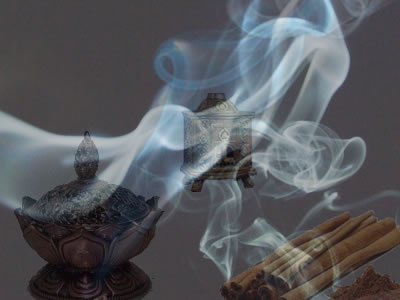Dhumapana is an Ayurvedic herbal smoking therapy for treating ailments (cough, bronchitis and asthma, etc). In this therapy, the person inhales herbal smoke to increases of kapha and Vata for treating or preventing the diseases.
Dhumapana (literally “drinking smoke”), has been practiced for over 2,000 years. The inhalation of medicinal smoke – inhaling of medicinal herbal smoke is employed as a remedy for many different ailments. This therapy is very helpful with removing mucus in the body, and treat the ailments such as wet cough, bronchitis and asthma caused by mucus. Dhumapana is also recommended to be performed for promoting general health or preventing diseases.
Benefits of Dhumapana
Dhumapana is beneficial for the following ailments:
– Wet Cough
– Bronchial spasms
– Bronchitis
– Asthma
– Dyspnoea
– Rhinitis
– Bad smell of the nose and mouth
Precautions and warnings for Dhumapana
Dhumapana should not be given to a person who is suffering from the following disorders:
– Dry cough
– Excessive thirst
– Insomnia
– Sore throat or diphtheria
– Bleeding disease
– Ascites
– Intestinal obstruction
– Diabetes
– Urinary tract disorders
– Flatulence or bloating
– Injured in the head
– Anemia
– Poisoned
– Blindness
Types of Dhumapana
There are three types of Dhumapana:
Snigdha Dhuma – mild, also known as Mrudu / Prayogika. It is used in Vata imbalance.
Madhya Dhuma – medium, also known as Shamana Dhuma. It is used in Vata and Kapha imbalance.
Teekshna Dhuma – strong, also known as Virechana dhuma. It is used in Kapha imbalance.
Methods and Tools of the Therapy – Herbal Smoking
Method 1: Use a smoke pot made from metals like gold, silver, iron, or use a earthen pot. A burning charcoal is placed inside the pot. Put herbs over it and the cover of pot has a hole at its center. A tube is connected to the hole, through which the smoke is inhaled.
Method 2: Sit close to a censer or incense burner, burn herbs in the vessel, and inhale the smoke through nostrils.
Method 3: Make a smoke wick: Use a reed, twelve inches in length, soaked in water for 24 hours. Then wrap it in 3-5 layers of cloth, which is smeared with thin paste of herbs. Let be dried in shade, remove the reed, smear with fat material (oil or ghee). Insert it into the smoking tube, light with fire and inhales the smoke.
Method 4: Use a piece of cloth, put the herbal medicine on it, let it rolled very tightly and tied at the end to hold the herbs. Make it look like a cigar. Lit and hold it close to the nose, inhale the smoke in nostrils.
Method 5: Use a piece of paper wrap leaves or powder of the herbs, making it into a cigarette-like stick. Light it and smoke it like smoking a cigarette.
Method 6: Use a tobacco pipe, put the herb leaves in the chamber of the pipe, light it and smoke it, just like smoking tobacco with the pipe.
How to Perform Dhumapana – Herbal Smoking
The patient should sit straight and relax.
Traditionally, the smoke should be inhaled by each nostril. The smoke is inhaled from one nostril and then breathe out from another nostril. Use fingers to open and close each nostril. Repeat on each side.
Smoking should be done thrice, with three times inhaling and three exhaling alternately.
Snigdha – mild strength smoke – 1 set of 3 inhales and exhales.
Madhya – medium strength smoke – 2 sets of 3 inhales and exhales.
Teekshna – strong strength smoke – 3 or 4 sets of 3 inhales and exhales.
Herbs and Materials for Dhumapana
Medical Herbs:
Medical Herbs for Snigdha – mild strength smoke:
Valaka, Guggulu, Aguru, Shaileya, Nalada, Musta, Sthauneya, Usheera, Varanga, Kounti, Madhuka, Shrivestaka, Sarjarasa, Dhyamaka, Bilvamajja, Elavaluka, Madana, Plava, Shallaki, Yava, Kunduruka, Tila, Kumkuma, Masha.
Medical Herbs for Madhya – medium strength smoke:
Shallaki, Laksha, Utpala, Barks of Nyagrodha, Udumbara, Prithvika, Kamala, Asvattha, Plaksa and Rodhra, Suvarnatwak, Padmaka, Sita, licorice, Raktayastika Kustha, Tagara.
Medical Herbs for Teekshna – strong strength smoke:
Turmeric, Jyotismati, Laksa, Shweta, Triphala, Dashamula, Ala, Other substances with strong smell.
Flammable and combustible materials:
To support the burning process, you might need to mix flammable and combustible materials with the medical herbs, or sprinkle the herbs over the burning charcoal.
Charcoal, animal fats, ghee and plant oils can be used as flammable and combustible materials. Do not use chemical fuels.
Three Dhumapana Recipes
Recipe 1 – Turmeric, black Pepper and licorice for mucus and headaches:
– Equal parts of turmeric, black Pepper and licorice powder
– Add some ghee to it
– Mix them well and make it a peanut butter-like paste
– Wrap the mixture in a cloth, making it look like a cigar
– Light and hold it close to your nose
– Let the smoke be inhaled by your nostrils
This treatment is effective in removing mucus in the upper body and alleviating headaches.
Recipe 2 – Vasaka and clove for cough and bronchitis:
– 3 parts of vasaka leaves
– 1 parts of ground cloves
– Wrap the herbs in a piece of paper, making it look like a cigarette
– Lit it and let the smoke be inhaled by your nostrils
This treatment is effective in treating cough with phlegm and bronchitis. Vasaka relieves thick phlegm, provides relief and helps breath normally.
Recipe 3 – Cloves, ground betel nut and tobacco for cough:
– 1 part of ground cloves
– 4 parts of ground betel nut
– 2 parts of tobacco
– Wrap the herbs in a piece of paper, making it look like a cigarette
– Smoke it just like smoking a cigarette
This therapy is effective for treating cough with mucus.



